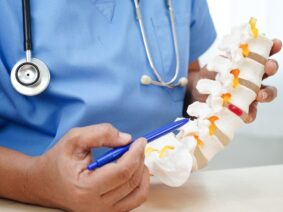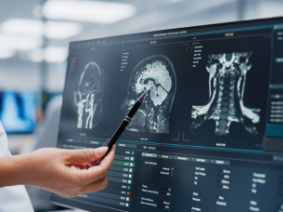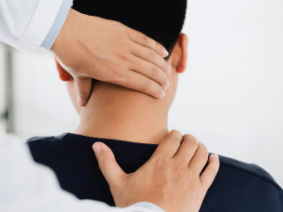Cervical and Lumbar Radiculopathy
What Is Radiculopathy?
Radiculopathy defines a range of symptoms caused by a pinching of a nerve root in the spinal column. The spinal cord runs through a canal in the center of the vertebrae. Nerve roots split from the cord and travel between the vertebrae and into various areas of the body. When these nerve roots become damaged or pinched, the symptoms are called radiculopathy.
The pinched nerve can occur at different areas along the spine, including the cervical and lumbar areas.
Cervical Radiculopathy (Pinched Nerve)
Cervical radiculopathy occurs due to irritation of the spinal nerves in the neck. These nerve root injuries are commonly referred to as “pinched nerves,” and cause pain and numbness in the neck that radiates down the shoulder and into the arm.
Lumbar Radiculopathy (Sciatica)
Lumbar radiculopathy, commonly known as sciatica, is pain in the lower extremities that radiates from the lumbar spine (lower back). Pain is caused by compression at the roots of the spinal nerves, and generally causes discomfort in the lower back, hips, and thighs, and travels down the legs. Compression most often occurs when the cushioning material in the intervertebral discs puts pressure on the nerves, by either bulging out or extruding out through a tear in the disc membrane.
Symptoms
When a nerve root is compressed, it becomes inflamed, which can cause several uncomfortable symptoms, including:
- Sharp pain or a pins and needles sensation
- Numbness
- Muscle weakness
- Pain radiating through the lower extremities
- A “popping sound” when moving the lower back
- Tingling
- Difficulty moving the lower extremities
Symptoms will depend on where the nerve root is being pinched. It is possible that no symptoms will be experienced, or that they will come through periodic flare-ups.
Causes:
- Herniated discs. Spinal discs act as cushions between vertebrae, and if these discs slip out of place or become damaged, they can press on nerves. This is most common in lumbar radiculopathy.
- Foraminal Stenosis. When a foramen, or the bony opening where a nerve root exits the spinal canal, narrows or becomes smaller, the nerve root has less space and may become pinched.
- Bone Spurs. Bone spurs are areas of extra bone growth. They can form in the spine due to inflammation from osteoarthritis, trauma, or other degenerative bone conditions and cause pressure to nerves.
- Thickening of spinal ligaments. Thickening of the spinal ligaments can lead to narrowing of the space around the nerve root and nerve compression.
A fracture, tumor, or infection can also cause radiculopathy, but these causes are much less common.
Treatment
A wide range of treatment options are available for radiculopathy. Nonsurgical treatments are usually recommended first and include:
- Physical therapy to strengthen the muscles in a customized routine that will prevent further damage and injury
- Weight loss strategies that will attempt to reduce pressure on the problem areas
- Medications, such as nonsteroidal anti-inflammatory drugs (NSAIDs), opioid medicines, or muscle relaxants prescribed by a doctor to help manage pain symptoms
- Steroid injections to reduce inflammation and temporarily relieve pain
When conservative treatments don’t keep the symptoms at bay, surgical options are available. Surgery is used to reduce the pressure on the nerve root by widening the space where nerve roots exit the spine. Common surgical options for radiculopathy are:
- Discectomy. This surgery creates a small incision to remove the herniated or damaged disc and then fuses the remaining vertebrae to restore normal height and to give spinal nerves enough room to ensure stability.
- Artificial disc replacement. In this procedure, the problematic disc is replaced with an artificial disc, instead of a fusion, aiming to maintain mobility at that level of the spine.
- Laminectomy. This surgery removes the lamina, or bony plate on the back of the affected vertebrae, to take pressure off the spinal nerve root or spinal cord.
Radiculopathy symptoms don’t have to slow you down. For more information about radiculopathy or to schedule an appointment with one of our expert neurosurgeons, contact us today.



